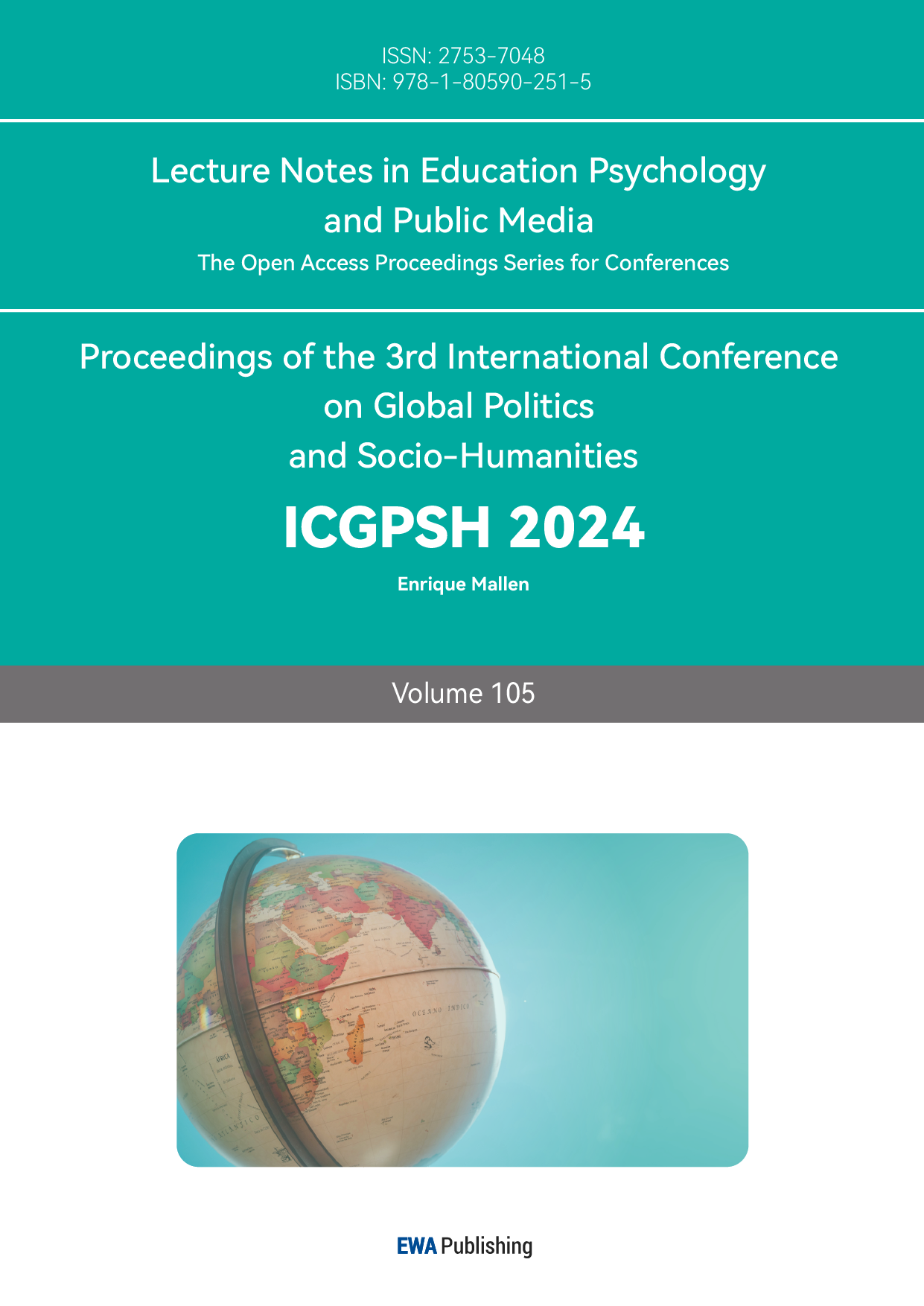1. Introduction: the international climate law framework
CBS News reported that environmental issues top the list of global concerns in the status quo [1]. Specifically, climate change refers to the shift in weather patterns due to human activities and other variables. As the world enters an industrialized era, problems concerning the climate have given rise to numerous discussions in academia and pose fatal threats to humanity. However, despite these efforts, it is quickly becoming apparent that the globe needs a 1000% increase in climate finance to achieve the Paris goals, or else the temperature will rise by another 200% compared to the anticipated results [2]. Therefore, this forges scholars to wonder: Is the Nationally Determined Contributions (NDC) system adequately effective in meeting the 2℃ goals with respect to developed and developing countries, and how could the Paris Agreement do more to incentivize climate mitigation from states?
The NDC system is less effective for developed countries than for developing countries because developing countries have greater ambition due to their climate incentives (such as confronting their environmental vulnerabilities), while developed countries may lack determination and face no consequences for under-ambition. Nationally Determined Contributions refer to the individual commitments pledged by each party, and their ambition refers to how much they are willing to devote to climate efforts. Since the NDC system prioritizes capacity building over commitment enforcement, delving into the correlations and causations of the NDC’s ineffectiveness towards developed countries would help theorize solutions to enhance global climate collaboration.
The first part of the paper provides a comprehensive literature review that addresses scholarly opinions on the major climate agreements, particularly focusing on the Paris Agreement and the NDC system within it. The second part of this paper lays out the hypotheses and methodology. Section three provides six case studies with diversified perspectives collectively conveying insights into the Paris Agreement. Section four presents five key recommendations for improving the NDC system: international institute for transparency, non-state actors, re-engaging CBDR, climate club, and multi-faceted NDCs. Finally, this paper concludes with indications of potential further research.
2. Literature review: prominent climate agreements and their dissections
Scholars have conducted sundry findings on the relationship between international climate law and the parties themselves. This connection is often associated with whether the current NDC framework effectively holds authority in presiding over the state parties to 1) make sufficient climate commitments and 2) carry out their commitments.
2.1. The law - history of international climate law and their impacts
The cornerstone of international climate law can be traced back to the Intergovernmental Panel on Climate Change and the United Nations Framework Convention on Climate Change, both of which are international institutions established to provide a global framework for state parties to address environmental issues [3-4]. However, while these platforms laid the foundation for future international climate law, both failed to enforce substantive climate commitments.
As one of the outcomes of the UNFCCC membership meetings, the Kyoto Protocol was formed during COP 3 with the first official global climate target: “reducing…overall emissions of such gasses by at least 5 percent below 1990 levels in the commitment period 2008 to 2012” [5]. However, this protocol was inadequate due to it not involving any developing countries and setting up a binding agreement that lacked enforcement policies, thereby failing to fulfill any substantive achievements in the end.
Perhaps the most impactful treaty in international climate law is the Paris Agreement signed in COP 21. This agreement’s primary goal is to hold “the increase in the global average temperature to well below 2°C above pre-industrial levels” [6] with the commitment of all parties. Under this system, there are Nationally Determined Contributions belonging to the Common but Differentiated Responsibilities system; rather than enforcing binding agreements like Kyoto, the Paris Agreement inducted semi-voluntary climate action goals decided by states themselves (NDCs) that recognize the different capabilities and circumstances of each party (CBDR).
2.2. The debates - scholarly views on international climate establishments
The central focus of this paper is the nuanced NDC system and the three themes related to it: CBDR, binding agreements, and equity. In response, scholars have provided commentary surrounding these different components, showcasing their influences and potential impacts on the international legal system.
Mehrotra and Emmanuel Olatunbosun affirm the overall NDC approach by proposing how this enhancement will help achieve long-term climate goals. NDCs' benefits range from building political will and societal ownership at national and sub-national levels to reviewing, aligning, and updating existing targets, policies, and measures. This will help low socio-economic development countries have better capacities to develop and implement climate policies and take climate action, and more than 90% of the countries receiving support will have well-designed and robust climate targets.
Similarly, Breidenich, McGraw, Rowley, and Rubin view that the international climate system needs to involve all stakeholders, including developing countries, to ensure long-term success [7]. Therefore, binding arrangements are dismissive towards developing countries that depend on industrialization for economic improvement, thus making them inequitable.
Castro suggests that the CBDR system also played an important role in developing countries’ climate commitments, which is essential in securing the participation of nations like South Africa in the Paris Agreement [8]. Studies show the Paris Agreement’s autonomy system has roughly 5x more involvement rates and 10x more total commitments than the Kyoto Protocol’s binding agreement [9] [10]. Most of this gap falls under the developing countries section, as its participation rates skyrocketed by an astounding 20000% [11]. Referring back to the marginally different policies in Kyoto and Paris, this logically coheres because of the nature of premature binding agreements that limit the possibilities of feeble parties’ participation [12-13].
Contrarily, Musasia negates the current Paris policies, for he believes NDCs are not immune to global and national politics and contemporary tensions [14]. Moreover, Stern argues against the NDC’s hybrid legal form because relying on rising norms rather than legally binding targets with penalties often results in a bottom-up provision that involves little incentives [15]. Therefore, he believes that the CBDR system is failing to prevent humanitarian destruction, for the soft-voluntary system lacks enforcement mechanisms that obligate developed nations to provide sufficient international support to vulnerable areas. However, neither scholar explicitly considers the reality of international policy-making to be all about the state’s goodwill, and more often than not, these parties do not wish to restrain themselves with disadvantageous policies.
In another refutation against the CBDR arrangement in the NDCs, Avasarala and Ebinger suggest environmental pragmatism [16]. In this approach, climate mitigation responsibilities are transferred to a smaller, agile forum of paramount importance (similar to Annex I in Kyoto) because adding most developing nations to the process would make it “[unnecessarily] cumbersome.” Regardless, Avasarala and Ebinger fail to consider the globality of climate concerns; simply ousting anemic developing countries is inequitable and immoral, for it marginalizes the international responsibility of this climate affair. Involving private sectors in international law is difficult, too.
Analogously, Swingle adds to the deliberation by emphasizing the themes of fairness and equity in the CBDR system, as it builds mutual trust and collaboration. The author also reveals a disagreement between developing and developed countries based on national interests, demonstrating a point of impasse in international climate law. Developing countries highlight historical responsibilities, for developed states have historically emitted more greenhouse gasses and thus boosted their economy today. In contrast, developed countries believe it should be based on future emission responsibilities and collective cost-effectiveness [17].
Martinez-Zarzoso and Brunewald’s studies demonstrate a lack of collective commitments from developing countries without a binding commitment in the Paris Agreement [18]. Nordhaus and Boyer add to this view by suggesting the economic inefficiency of present climate action due to a lack of technological investments, comprehensive coverage, and motivation [19].
Gerrard proposes involving non-state actors and using the investment methodology and “fair and equitable benefit-sharing” amongst countries as a technique for a sufficient income stream [20]. Current IPCC reports show that achieving the 2℃ goal is now nearly impossible, and the globe needs, in reality, $1.6 Trillion in climate investment [21]. Likewise, the United Nations Framework on Climate Change advocates for the support provided to developing countries and comments on the current NDC system, hinting that global collaboration for climate advancements would require abundant economic and social transformation [22]. To establish international climate action with applicable and sufficient commitments, there needs to be subsistence in the realm of finance, technology, and capacity-building provided to developing countries.
It is important to recognize the thinkers’ views on the immediate need for a strategy that will drive countries into willfully making climate contributions, but these desirable outcomes cannot happen if countries do not collectively negotiate their disagreeing views on climate responsibility. Nonetheless, it is equally significant to acknowledge a lack of scholarly research on how to make the changes suggested in an international setting while considering the interests of both developing and developed countries. While the CBDR and NDC systems are efficacious in recognizing global differences and fairly balancing responsibilities, they simultaneously reveal a need for a more powerful yet pragmatic implementation procedure under this scheme. Still, the question remains on how this support can be sufficiently provided in the international framework, for it can only exist with an incentivizing and/or enforcement mechanism under the apparatus of a mutually-beneficial situation.
3. Methodologies and hypotheses: mixed-method research
This paper will use mixed methods of qualitative and quantitative research and incorporate both targeted and widespread case studies to address the varying hypotheses. It is challenging to measure countries’ exact implementation of their NDC targets because they often hide their accurate implementation information or do not make it clear. For this paper’s case studies, the data depicted is a result of averaging reliable primary and secondary sources.
First, the author will endeavor to scrutinize references from three representative developed parties: the United States, the European Union, and Saudi Arabia, as well as from three prominent developing countries: China, South Africa, and Kazakhstan; since the research query concerns the effectiveness of NDCs for developing and developed countries, analyzing nations from both circuits (in differing situations) would answer the hypotheses comprehensively. Secondly, the paper will examine these countries’ NDCs, data on total emission reductions versus committed, and previous climate cases/agreements with different variables. Finally, there will be an analysis of the data gathered, application to the hypotheses, and examination of the answers to the hypotheses in the two scenarios of developing countries and developed countries.
Below are the statements of hypotheses:
|
H1: The NDC system is not effective in meeting the 2℃ goal due to insufficient and unambitious commitments. |
H1a: Developed Countries |
|
H1b: Developing Countries |
|
|
H2: The NDC system is not effective in meeting the 2℃ goal due to a lack of implementation and enforcement mechanisms. |
H2a: Developed Countries |
|
H2b: Developing Countries |
|
|
H3: The NDC system is effective in meeting the 2℃ goal because of the CBDR system in Article 2 of the Paris Agreement, which promotes voluntary compliance (autonomy), therefore empowering states to participate. |
H3a: Developed Countries |
|
H3b: Developing Countries |
4. Case studies: countries’ NDC pledges and their purpose
4.1. Case study I: united states’ climate commitments under the NDC system
The United States is one of the top emitters historically and presently, and its NDC target aims for an “economy-wide target of reducing its net greenhouse gas emissions by 50-52 percent below 2005 levels in 2030” [23]. In 2022, The United States provided an additional $5.8 billion in global climate funds, marking a 286% increase from the previous year [24] and thus indicating a somewhat benefit of the NDC system.
|
Reduced Gas Emissions |
Sector-Specific (Other) Targets |
|
|
Committed |
50-52% |
Commitment |
|
Implemented |
15.5% |
∼30% |
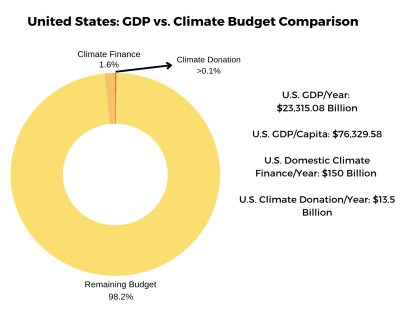
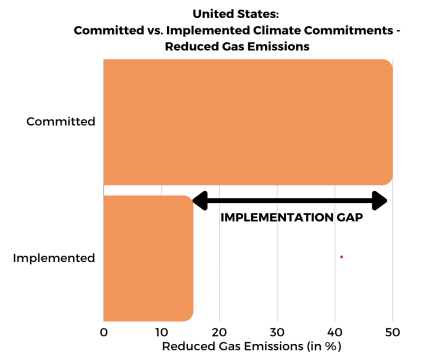
Nevertheless, climate support for developing countries and other organizations accounts for less than 0.1% of the United States’ GDP looking at Figure 1, and even domestic climate finance is a minimal 1.6%, indicating a lack of ambition. In addition, the United States has not been able to fully implement its pledges, with a nearly 4x gap. With a divided congress and partisan politics (2-party system), it is difficult to pass comprehensive climate legislation, challenging large-scale climate action.
Overall, the United States is ranked insufficient regarding climate action [32]. It remains imperative that without drastic emission reduction measures, it will be difficult for the state to meet its domestic climate targets. There are two problems: 1) the commitments are not being carried out to their full extent, and 2) the commitments, considering the U.S.’ emissions and financial capability, are far from enough. Clearly, the U.S. has the financial capacity to make more ambitious pledges, so the issue then becomes incentives.
4.2. Case study II: european union’s climate commitments under the NDC system
The European Union is also one of the top emitters in the globe today while also holding the most historical emissions being the origin of the Industrial Revolution. It aims for “at least 40% economy-wide reduction of greenhouse gas emissions by 2030, compared to 1990 levels” [33]. The EU’s newest commitments in 2023 present around a 30% increase from the prior commitment (Ibid.).
|
Reduced Gas Emissions |
Sector-Specific (Other) Targets |
|
|
Committed |
90% |
Commitment |
|
Implemented |
32.5% |
∼50% |
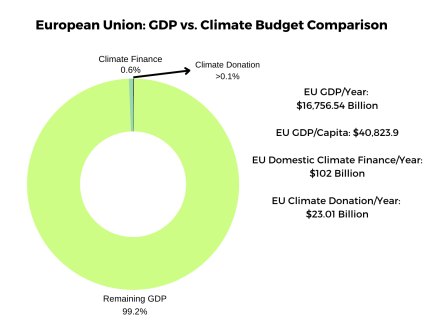
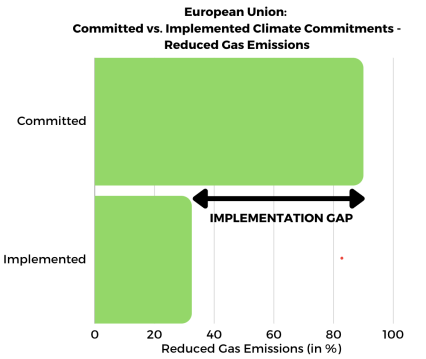
This data from figures 3 and 4 show that climate finance is only 0.6% of the EU’s GDP/year, and the financial aid provided for developing countries is less than 0.1%, revealing its further potential for another 2-3% increase. This results from geopolitical tensions such as the Russia-Ukrainian War, which caused economic pressures, inflation, and reduced industrial demand.
The EU is also ranked insufficient for its climate actions, for it still needs to get on track to fulfill its targets [40]. Similar to the U.S. in terms of dilemmas, the EU needs to make more commitments and implement them. Though different in political structure, it is difficult for both parties to execute their targets in an appropriate way under the NDC system, further validating the NDC system’s ineffectiveness towards developed countries.
4.3. Case study III: saudi arabia’s climate commitments under the NDC system
Saudi Arabia is a wealthy Middle Eastern country known primarily for its focus on petroleum and related industries [41]. As a result, it emits a significant amount of greenhouse gasses (GHG) annually. In response, the country has set a goal to "achieve net-zero greenhouse gas (GHG) emissions by 2060" [42].
|
Reduced Gas Emissions |
Sector-Specific (Other) Targets |
|
|
Committed |
Net-zero emissions by 2060 (∼100%) |
50% renewable energy |
|
Implemented |
+2.93% (607,907,500 tons) |
> 1% |
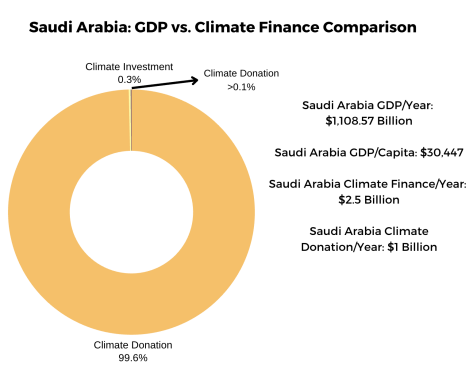
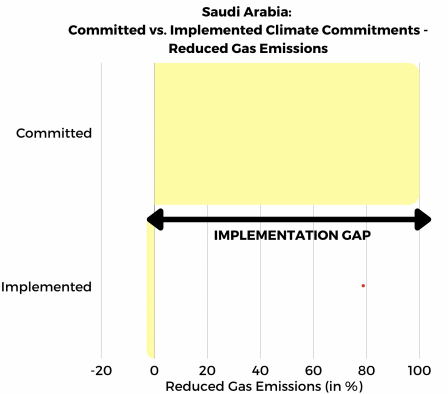
In practice, the Kingdom’s implementation of climate actions does not align with its seemingly “ambitious” targets. Only 0.2% of its annual national GDP is allocated to climate funding looking at Figure 5, and instead of reducing greenhouse gas (GHG) emissions, Saudi Arabia increased its emissions by nearly 3%. As one of the world's largest emitters, Saudi Arabia is not making sufficient or accountable commitments to reducing its GHG output. However, it is understandable that Saudi Arabia’s economy heavily depends on oil extraction, which accounts for 45% of its entire economy [46].
Saudi Arabia is one of the few countries in the world that is critically insufficient in climate action [47]. This clearly illustrates that the Common but Differentiated Responsibilities (CBDR) and Nationally Determined Contributions (NDC) systems under the Paris Agreement are not adequate for uncooperative countries like Saudi Arabia. It also highlights a weakness in the current climate framework: the need to motivate and require countries, particularly in the Middle East, that rely on oil extraction and usage to commit to higher climate targets and take more ambitious climate actions.
4.4. Case study IV: china’s climate commitments under the NDC system
China is the world's largest carbon emitter today, with 11,397 million metric tons emitted in 2022 [48]. Its NDC target aims to “peak carbon dioxide emissions before 2030…[and] achieve carbon neutrality before 2060” [49]. China’s new 2021 NDCs increased climate ambitions by 4% in just one year [50].
|
Reduced Gas Emissions |
Sector-Specific (Other) Targets |
|
|
Committed |
65% |
Commitment |
|
Implemented |
48.4% |
∼30-40% completion |
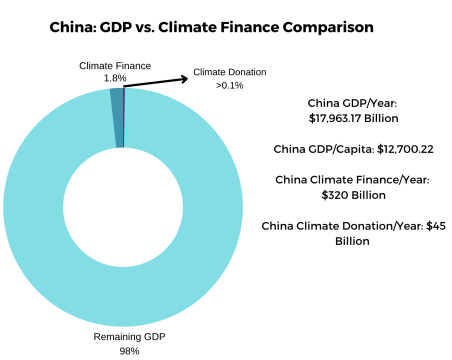
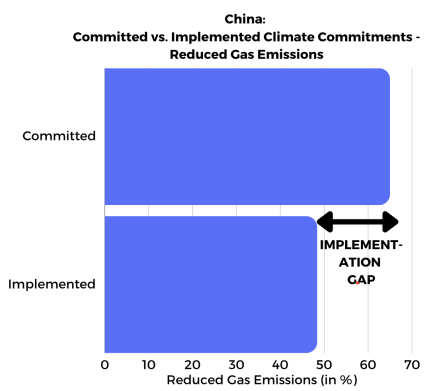
China is instituting fairly ambitious climate assurances, with 1.8% of its massive GDP devoted to climate finance observing figure 7. With an immense population, though, there are challenges dealing with dependencies on coal usage and budget devotion, possibly even causing inflation.
After all, China is highly insufficient in its overall climate action [56]. Both the NDC target itself and the domestic policies surrounding it are currently insufficient due to two problems: 1) too much carbon output is needed for the current country to function, and 2) contemporary commitments are too low, and there are no critical reductions before 2030. One needs to consider that while China might seem to almost fulfill its target via its >50% completion rate, the issue here is that the target itself needs to be revised and enlarged.
4.5. Case study V: south africa’s climate commitments under the NDC system
Since it does not have a large population nor industrial power, South Africa has not historically contributed much to climate change. However, as South Africa begins to develop its economy and uses greenhouse gasses in the near present, its total carbon emissions have increased by over 67% since 1990 [57]. South Africa’s 2021 climate commitments indicate a plan to limit its annual greenhouse gas (GHG) emissions to a range of 398-510 Mt CO2-eq (17.76%) by 2025 and 350-420 Mt CO2-eq by 2030 (32%) [58]. For South Africa, along with many other developing countries, conditional pledges are crucial, possibly supporting a 15x increase in their climate action initiatives and thereby reflecting both their ambition and the financial deprivation that restrains them.
|
Reduced Gas Emissions |
Sector-Specific (Other) Targets |
|
|
Committed |
17.76% |
Commitment |
|
Implemented |
∼10% |
N/A |

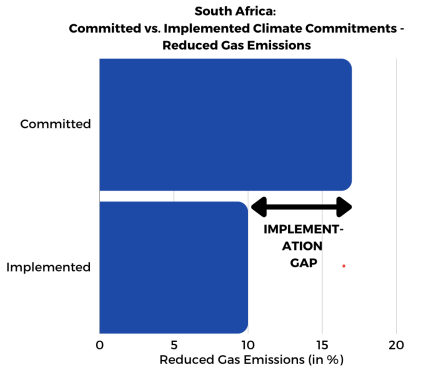
Considering South Africa has nearly 1/2590 of an average developed country’s GDP, it is no shock that their commitments are lower. They are, even so, making a good faith effort, devoting 2.2% of their GDP to climate finance, inspecting on Figure 9. Shockingly, this is more in proportion than both the U.S. and the EU. What is preventing South Africa from further NDC commitments is its desired transition into a more economically suitable country, requiring a great amount of coal. There are also social challenges, for this developing country lacks resources, finance, and technology, especially since it is highly vulnerable to climate impacts.
South Africa’s NDC targets are ranked insufficient [64]. Its NDC objectives are almost achieved, but the policies and actions are inadequate due to the country’s incapability and uncertainty. It is important to note that although the graded score is the same “insufficient” as the United States and the European Union, the problem here is not ambition but rather a lack of capability. This case reveals that developing countries often want to do more than they are able to, but are not receiving enough external help to fuel that ambition. There are three problems: 1) emissions reduction contradicts the development plan, 2) low commitments because of lack of resources and budget, and 3) insufficient financial and technological support received.
4.6. Case study VI: kazakhstan’s climate commitments under the NDC system
As a rising power in Central Asia, Kazakhstan is actively engaged in climate action to reduce its carbon footprint. The country’s NDC target aims for a "15% reduction in GHG emissions by the end of 2030." Additionally, its conditional pledge seeks a "25% reduction in GHG emissions by the end of 2030" [65]. For this developing nation, the conditional targets are nearly double the unconditional ones, highlighting the crucial role of international support in enabling developing countries to achieve more ambitious climate commitments.
|
Reduced Gas Emissions |
Sector-Specific (Other) Targets |
|
|
Committed |
15% GHG reduction |
25% GHG reduction |
|
Implemented |
7.98% GHG reduction |
N/A |
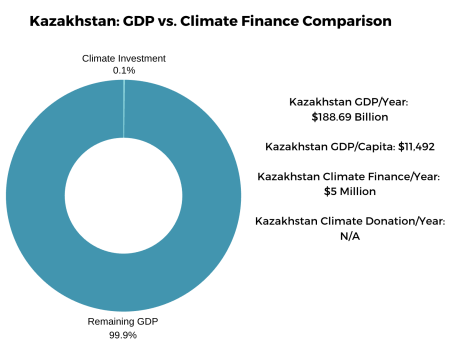

Echoing the results from the previous two developing countries, Kazakhstan is making respectable climate efforts but could pursue further initiatives. Like China and India, Kazakhstan's climate efforts are considered insufficient [70]. However, unlike those nations, Kazakhstan's geopolitical situation presents unique challenges to implementing climate action. These obstacles include regional instability in Central Asia (such as conflicts in Afghanistan, Russia, and Ukraine), air and water pollution, economic dependence on oil and gas, authoritarian governance, and political difficulties.
4.7. Cross-cutting analysis: answering hypotheses via case studies
All of the countries examined in the two major groups present different financial, political, geographical, and demographic climate capacities; both are ineffective and face challenges in some manner. Developed countries lack incentives, face domestic political pressure, and feel a sense of excessive burden; developing countries lack essential inputs for environmental development.
In a final evaluation, these case studies confirm Hypothesis 1a because the NDC data from developed countries shows inadequacy and non-ambition. They simultaneously confirm and falsify Hypothesis 1b because developing countries are making a good climate effort in ratio to their abilities. They confirm Hypothesis 2a because developed countries are not fulfilling their commitments and not making sufficient pledges. They intermediate Hypothesis 2b because the data provided do not overly suggest the difference that strict enforcement mechanisms would make. They falsify Hypothesis 3a because the CBDR's voluntary procedures allow developed countries to escape their duties. Finally, they confirm Hypothesis 3b because more than 150 developing countries are now part of the global climate action due to the CBDR system.
5. Recommendations: potential solutions to incentivize state’s climate commitments
With these results in mind, the first recommendation is to establish an international institute for transparent reviews of countries’ NDC targets via adding a system under the UNFCCC or creating a consortium-like protocol [71]. Countries slacking on climate commitments can often get away with non-ambitious goals. Unlike already-existing organizations such as the IPCC or UNFCCC themselves, this third-party institute would provide a fair, common benchmark with the same standards to conclude an expected commitment for each country based on their capabilities that will fulfill the 2℃ goal collectively (after workshopping the data given to the UNFCCC every five years and conducting additional investigations to ensure their accuracy). Countries will receive guidance on their appropriate amount of climate action, and their commitment and implementation status will be exposed to the international setting. Using the principles of soft paternalism, this transparency indirectly obligates states to own up to their responsibilities and prevent excuses in the fear of ruining their reputation and political pressure. One might argue that countries can ultimately still refuse to fulfill their duties. Still, this methodology increases the chances that countries will draft and implement their pledges sufficiently and has proven to work several times (i.e. EU-Poland Climate Action Negotiations [72]).
The second recommendation is increasing national climate finance via non-state actors. Studies show that developing countries will need $2 trillion dollars per year to combat the negative impacts of climate change, and currently, developing countries like South Africa want to exceed their current capabilities but are constrained because of governmental finance [73]. Since governments, both developed and developing ones, are either unable or unwilling to devote a large budget to climate action, providing benefits as incentivizing variables to private businesses that are willing to 1) lend the government money specifically for climate action, known as a “climate debt,” 2) reduce carbon usage internally (within the company), or 3) other climate action externally (outside of the business) will supply a stable climate finance flow. Such benefits can include reduced taxes, softer policies, credits, etc. One might refute that if developing countries are financially struggling, where will private corporations' money come from? In response, the government’s money + non-state actors’ money will always be greater than or equal to the government’s money alone. Additionally, businesses have investment strategies that governments often lack. In South Africa, for example, some of the most profitable businesses are ones in the field of renewable energy [74].
A third possibility to promote more ambitious climate action is resolving the debate on fairness and equity by re-engaging the principle of CBDR. In their pathway to more ambitious commitments, developed countries believe that since they are already doing more than developing countries, they should not be regulated with further burdens. This disagreement on fair share and responsibilities has made it hard for sufficient global collaborations. Therefore, there needs to be international negotiations, potentially during the next COP meeting, surrounding climate equity and setting a unified notion. A potential theory addressing this issue is to use the idea of proportionality as the evaluation means instead of focusing on the absolute amount of money itself. This theory recognizes that it is impossible for developing countries to contribute the same amount of finance as developed countries, but further enhances the CBDR system by altering the unit of comparison so all countries have an “equal sign” in some regard that is non-discriminatory and justified. This would undoubtedly increase developed countries’ climate incentives, to, for example, South Africa’s proportion of 2.2% of national GDP instead of developed countries’ current <1%.
Fourth, there is the climate club theory proposed by William Nordhaus [75]. The climate club model addresses the shortcomings of the current climate framework. In response to the exposed gaps, there have been proposals for an international organization that does not have the direct authority to punish any particular country but instead employs the principles of libertarian paternalism to use regional incentives to encourage states to participate in climate actions. This model exists in various forms, such as the G7 Climate Club, the EU Climate Club, and others. It aims to overcome the problem of free-riding, which plagues voluntary agreements, by indirectly influencing state behavior through mechanisms like the Emissions Trading System (ETS), National Energy and Climate Plans (NECPs), and the Carbon Border Adjustment Mechanism (CBAM) [76-78]. The climate club model also incentivizes state compliance through economic and political interests, with specific methods including tariffs, sanctions, and political pressure. While different versions of the model offer distinct advantages, it overall serves as an enhancement to the current climate framework.
Finally, the case studies highlight the diversity among states, whether in terms of geography, politics, economics, or governance. These differences affect each state's climate efforts and capabilities. As a result, international climate law should move away from a one-size-fits-all approach and instead encourage varied forms of NDC systems tailored to different types of states (e.g., distinct climate clubs for different regions).
Broadly speaking, since international law does not have power beyond what the states are willing to commit to, the international legal system needs to develop alternative methods to convince states to engage in tasks that are not in their national interest but beneficial to the collective whole (if they do not comply with the above recommendations). Some ways include economic/trade sanctions, benefits-exchange, striving for a win-win situation, reputational motives, global transparency, and harmonious systems thinking (doing your own part to make the entire thing work).
6. Conclusion: future of international climate law
In light of these findings, the thesis: that the NDC system is less effective for developed countries than for developing countries because developing countries have greater ambition due to their climate incentives, while developed countries may lack determination and face no consequences for under-ambition, has been proven accurate.
This paper analyzed developing and developed countries’ NDCs and their respective compatibility. The results show that developing countries exert more effort under the NDC system because the CBDR mechanism’s main objective is capacity-building in developing states, hence failing to allocate much attention to incentivizing developed parties.
While this paper attempts to provide a thorough understanding of the effectiveness of the NDC system for both developing and developed countries, further research can be conducted to examine more case studies to develop an even more sophisticated explanation. Scholars can also delve deeper into potential solutions, or even draft a proposal for state carbon-reduction guidelines as part of the first recommendation in this paper.
Ultimately, there is only one world and one climate for all. Therefore, countries should not let minor other-worldly factors serve as excuses for their non-commitment in their pathway to constructing a sustainable future. States should do themselves, other countries, and the globe a favor by increasing their climate ambition and promoting global solidarity. Climate has no borders; international climate collaboration should not either.
References
[1]. Schechter, David, Haley Rush, and Chance Horner. 2024. “As Climate Changes, Climate Anxiety Rises in Youth. ” CBS News. April 12, 2024. https://www. cbsnews. com/news/climate-change-anxiety/.
[2]. Chau, Veronica, and Faheen Allibhoy. 2024. “Speed, Scale, Pragmatism: Hitting Climate Finance Goals in 2024. ” World Economic Forum. February 5, 2024. https://www. weforum. org/agenda/2024/02/climate-finance-resolutions-for-2024/.
[3]. “IPCC — Intergovernmental Panel on Climate Change. ” n. d. IPCC. https://www. ipcc. ch/.
[4]. UNITED NATIONS. 1992. “UNITED NATIONS FRAMEWORK CONVENTION ON CLIMATE CHANGE. ” https://unfccc. int/files/essential_background/background_publications_htmlpdf/application/pdf/conveng. pdf.
[5]. United Nations. 1998. “KYOTO PROTOCOL TO THE UNITED NATIONS FRAMEWORK CONVENTION ON CLIMATE CHANGE. ” https://unfccc. int/resource/docs/convkp/kpeng. pdf.
[6]. United Nations. 2015. “PARIS AGREEMENT. ” https://unfccc. int/files/essential_background/convention/application/pdf/english_paris_agreement. pdf.
[7]. Breidenich, McGraw, Rowley, and Rubin, “The Kyoto Protocol to the United Nations Framework Convention on Climate Change on JSTOR. ” n. d. Www. Jstor. Org. https://www. jstor. org/stable/2998044.
[8]. Castro, Paula. 2016. “Common but Differentiated Responsibilities Beyond the Nation State: How Is Differential Treatment Addressed in Transnational Climate Governance Initiatives?” Transnational Environmental Law 5 (2): 379–400. https://doi. org/10. 1017/s2047102516000224.
[9]. Rafferty, John P. 2024b. “Paris Agreement | Summary & Facts. ” Encyclopedia Britannica. July 30, 2024. https://www. britannica. com/topic/Paris-Agreement-2015.
[10]. “Kyoto 1st Commitment Period (2008–12). ” n. d. Climate Action. https://climate. ec. europa. eu/eu-action/international-action-climate-change/kyoto-1st-commitment-period-2008-12_en#:~:text=In%20the%20first%20period%20of, the%20bloc%20as%20a%20whole.
[11]. Foen, Federal Office for the Environment. n. d. “The Paris Agreement. ” https://www. bafu. admin. ch/bafu/en/home/topics/climate/info-specialists/climate--international-affairs/the-paris-agreement. html.
[12]. United Nations Framework Convention on Climate Change. 2024. “Emission Reductions under the Kyoto Protocol Pave the Way for Increased Ambition. ” United Nations Climate Change. July 19, 2024. https://unfccc. int/news/emission-reductions-under-the-kyoto-protocol-pave-the-way-for-increased-ambition.
[13]. Stallard, Esme. 2024a. “What Is the Paris Climate Agreement and Why Does 1. 5C Matter?” BBC News. February 8, 2024. https://www. bbc. com/news/science-environment-35073297.
[14]. M. , Betterman Simidi. 2024. “Has the Paris Agreement for Climate Change Failed?” Clean up Kenya, May. https://cleanupkenya. org/has-the-paris-agreement-for-climate-change-failed/.
[15]. Stern, Todd. 2018. “The Paris Agreement and Its Future. ” Brookings, October 2, 2018. https://www. brookings. edu/articles/the-paris-agreement-and-its-future/https://www. brookings. edu/articles/the-paris-agreement-and-its-future/.
[16]. Ebinger, Charles K. , and Govinda Avasarala. 2010. “Environmental Pragmatism. ” Brookings, April 22, 2010. https://www. brookings. edu/articles/environmental-pragmatism/.
[17]. Swingle, Claire. n. d. “Climate justice after the Paris Agreement: understanding equity through nationally determined contributions. ” A Research Agenda for Climate Justice.
[18]. Brunewald, Nicole, and Inmaculada Martinez-Zarzoso. n. d. “Did the Kyoto Protocol Fail? An evaluation of the effect of the Kyoto Protocol on CO2 Emissions. ” Cambridge.
[19]. Nordhaus, William D. , and Joseph G. Boyer. n. d. “Requiem for Kyoto: An Economic Analysis of the Kyoto Protocol. ” EliScholar – a Digital Platform for Scholarly Publishing at Yale. https://elischolar. library. yale. edu/cowles-discussion-paper-series/1449/?utm_source=elischolar. library. yale. edu%2Fcowles-discussion-paper-series%2F1449&utm_medium=PDF&utm_campaign=PDFCoverPages.
[20]. Gerrard, Michael B. 2014. “Will International Law Save Us From Climate Disasters?” Proceedings of the ASIL Annual Meeting 108 (January): 180–83. https://doi. org/10. 5305/procannmeetasil. 108. 0180.
[21]. Sherman, Nicola. n. d. “Inter-State climate technology transfer under the UNFCCC: A benefit-sharing approach. ” Wiley.
[22]. “The Paris Agreement. ” n. d. United Nations Climate Change. https://unfccc. int/process-and-meetings/the-paris-agreement.
[23]. The United States of America. n. d. “Reducing Greenhouse Gases in the United States: A 2030 Emissions Target. ” https://unfccc. int/sites/default/files/NDC/2022-06/United%20States%20NDC%20April%2021%202021%20Final. pdf.
[24]. “U. S. International Climate Finance: FY2024. ” 2023. Congressional Research Service. https://crsreports. congress. gov/product/pdf/IF/IF12036#:~:text=URL%3A%20https%3A%2F%2Fcrsreports. congress. gov%2Fproduct%2Fpdf%2FIF%2FIF12036%0AVisible%3A%200%25%20.
[25]. House, White. 2024. “FACT SHEET: The President’s Budget Creates Good-Paying Clean Jobs, Cuts Energy Costs, and Delivers on the President’s Ambitious Climate Agenda. ” The White House. March 12, 2024. https://www. whitehouse. gov/omb/briefing-room/2024/03/11/fact-sheet-the-presidents-budget-creates-good-paying-clean-jobs-cuts-energy-costs-and-delivers-on-the-presidents-ambitious-climate-agenda/.
[26]. “GDP per capita (current US$) - United States. ” n. d. World Bank Open Data. https://data. worldbank. org/indicator/NY. GDP. PCAP. CD?locations=US.
[27]. Buchwald, Elisabeth. 2023. “Climate change is costing the US $150 billion a year. Here’s what that looks like. ” CNN. November 30, 2023. https://edition. cnn. com/2023/11/30/economy/what-150-billion-climate-change-damage-looks-like/index. html#:~:text=Climate%20change%20is%20costing%20the%20US%20%24150%20billion%20a, Here's%20what%20that%20looks%20like&text=Wildfires%20in%20Lahaina%2C%20Hawaii%2C%20killed, to%20total%20almost%20%246%20billion.
[28]. “U. S. GDP 1960-2024. ” n. d. MacroTrends. https://www. macrotrends. net/global-metrics/countries/USA/united-states/gdp-gross-domestic-product#:~:text=U. S. %20gdp%20for%202021%20was, a%204. 13%25%20increase%20from%202018.
[29]. “Progress Report on President Biden’s Climate Finance Pledge - United States Department of State. ” 2023. United States Department of State. December 3, 2023. https://www. state. gov/progress-report-on-president-bidens-climate-finance-pledge/#:~:text=Total%20U. S. %20climate%20finance%20increased, million%20was%20for%20sustainable%20landscapes.
[30]. “Climate Change Indicators: U. S. Greenhouse Gas Emissions | US EPA. ” 2024. US EPA. June 27, 2024. https://www. epa. gov/climate-indicators/climate-change-indicators-us-greenhouse-gas-emissions.
[31]. Lashof, Dan. n. d. “Tracking Progress: Climate Action Under the Biden Administration. ” World Resources Institute. https://www. wri. org/insights/biden-administration-tracking-climate-action-progress.
[32]. Climate Action Tracker, “USA. ” n. d. https://climateactiontracker. org/countries/usa/
[33]. Spain and European Commission. 2023. “Update of the NDC of the European Union and Its Member States. ” https://unfccc. int/sites/default/files/NDC/2023-10/ES-2023-10-17%20EU%20submission%20NDC%20update. pdf.
[34]. “International Climate Finance. ” n. d. Climate Action. https://climate. ec. europa. eu/eu-action/international-action-climate-change/international-climate-finance_en.
[35]. “GDP per capita (current US$) - European Union. ” n. d. World Bank Open Data. https://data. worldbank. org/indicator/NY. GDP. PCAP. CD?locations=EU.
[36]. “European Union GDP 1960-2024. ” n. d. MacroTrends. https://www. macrotrends. net/global-metrics/countries/EUU/european-union/gdp-gross-domestic-product#:~:text=European%20Union%20gdp%20for%202022, a%201. 8%25%20decline%20from%202018.
[37]. “Delivering the European Green Deal. ” 2021. European Commission. July 14, 2021. https://commission. europa. eu/strategy-and-policy/priorities-2019-2024/european-green-deal/delivering-european-green-deal_en.
[38]. “Climate Action Progress Report 2023. ” 2023. Climate Action. October 24, 2023. https://climate. ec. europa. eu/news-your-voice/news/climate-action-progress-report-2023-2023-10-24_en.
[39]. “Climate Action. ” 2024. Climate Action. August 1, 2024. https://climate. ec. europa. eu/index_en.
[40]. Climate Action Tracker, “EU. ” n. d. https://climateactiontracker. org/countries/eu/.
[41]. Teitelbaum, Joshua, William L. Ochsenwald, and Harry St John Bridger Philby. 2024. “Saudi Arabia | History, Map, Flag, Capital, Population, & Facts. ” Encyclopedia Britannica. September 7, 2024. https://www. britannica. com/place/Saudi-Arabia/Economy.
[42]. “Saudi Arabia Net Zero GHG Emissions by 2060: Transformation of the Electricity Sector - KAPSARC. ” 2024. KAPSARC. February 8, 2024. https://www. kapsarc. org/research/publications/saudi-arabia-net-zero-ghg-emissions-by-2060-transformation-of-the-electricity-sector/.
[43]. “Saudi Arabia commits $2. 5 bln to Middle East green initiative - Crown Prince. ” 2022. Reuters. November 22, 2022. https://www. reuters. com/business/sustainable-business/saudi-arabia-commits-25-bln-middle-east-green-initiative-crown-prince-2022-11-07/.
[44]. “World Bank Open Data. ” n. d. World Bank Open Data. https://data. worldbank. org/indicator/NY. GDP. PCAP. CD?locations=SA.
[45]. Argus Media. “Saudi Arabia Favours Bilateral Climate Finance. ” Latest Market News, December 5, 2023. https://www. argusmedia. com/en/news-and-insights/latest-market-news/2507780-saudi-arabia-favours-bilateral-climate-finance.
[46]. Jawadi, Fredj, and Zied Ftiti. 2019. “Oil Price Collapse and Challenges to Economic Transformation of Saudi Arabia: A Time-series Analysis. ” Energy Economics 80 (May): 12–19. https://doi. org/10. 1016/j. eneco. 2018. 12. 003.
[47]. Climate Action Tracker, “Saudi Arabia. ” n. d. https://climateactiontracker. org/countries/saudi-arabia/.
[48]. Blokhin, Andriy. 2024. “The 5 Countries That Produce the Most Carbon Dioxide (CO2). ” Investopedia. July 27, 2024. https://www. investopedia. com/articles/investing/092915/5-countries-produce-most-carbon-dioxide-co2. asp.
[49]. “China’s Achievements, New Goals and New Measures for Nationally Determined Contributions. ” 2021. Report. China’s Achievements, New Goals and New Measures for Nationally Determined Contributions. https://unfccc. int/sites/default/files/NDC/2022-06/China%E2%80%99s%20Achievements%2C%20New%20Goals%20and%20New%20Measures%20for%20Nationally%20Determined%20Contributions. pdf.
[50]. Lui, Swithin. “Why China Is Set to Significantly Overachieve Its 2030 Climate Goals. ” 2022. World Economic Forum. June 1, 2022. https://www. weforum. org/agenda/2022/06/china-emissions-global-warming-climate-change-2030/.
[51]. “China Significantly Reduces Carbon Emissions Intensity. ” n. d. https://english. www. gov. cn/news/202307/12/content_WS64aeab0fc6d0868f4e8ddb9b. html.
[52]. Climate Policy Initiative. 2024a. “The Potential for Scaling Climate Finance in China / China’s potential to scale up climate finance - CPI. ” CPI. August 5, 2024. https://www. climatepolicyinitiative. org/publication/the-potential-for-scaling-climate-finance-in-china/.
[53]. “GDP per capita (current US$) - China. ” n. d. World Bank Open Data. https://data. worldbank. org/indicator/NY. GDP. PCAP. CD?locations=CN.
[54]. “China GDP 1960-2024. ” n. d. MacroTrends. https://www. macrotrends. net/global-metrics/countries/CHN/china/gdp-gross-domestic-product#:~:text=China%20gdp%20for%202022%20was, a%202. 77%25%20increase%20from%202018.
[55]. Liu, Shuang. “China Is Providing Billions in Climate Finance to Developing Countries. ” World Resources Institute, n. d. https://www. wri. org/insights/china-climate-finance-developing-countries#:~:text=Our%20estimate%20shows%20that%20the, provided%20during%20the%20same%20period.
[56]. Climate Action Tracker, “China. ” n. d. https://climateactiontracker. org/countries/china/.
[57]. Ritchie, Hannah, Max Roser, and Pablo Rosado. 2020. “CO₂ And Greenhouse Gas Emissions. ” Our World in Data. May 11, 2020. https://ourworldindata. org/co2/country/south-africa.
[58]. “SOUTH AFRICA FIRST NATIONALLY DETERMINED CONTRIBUTION UNDER THE PARIS AGREEMENT. ” 2021. South Africa’s First NDC, 2020/21 Update 1. https://unfccc. int/sites/default/files/NDC/2022-06/South%20Africa%20updated%20first%20NDC%20September%202021. pdf.
[59]. “South Africa Takes the High Ambition Path | NDC Partnership. ” 2021. November 27, 2021. https://ndcpartnership. org/news/south-africa-takes-high-ambition-path.
[60]. “GDP per capita (current US$) - South Africa. ” n. d. World Bank Open Data. https://data. worldbank. org/indicator/NY. GDP. PCAP. CD?locations=ZA.
[61]. Meattle, Chavi et al. 2024b. “The South African Climate Finance Landscape 2023 - CPI. ” CPI. August 5, 2024. https://www. climatepolicyinitiative. org/publication/the-south-african-climate-finance-landscape-2023/.
[62]. “South Africa GDP 1960-2024. ” n. d. MacroTrends. https://www. macrotrends. net/global-metrics/countries/ZAF/south-africa/gdp-gross-domestic-product#:~:text=South%20Africa%20gdp%20for%202022, a%203. 93%25%20decline%20from%202018.
[63]. “Presidential Climate Commission. ” n. d. https://www. climatecommission. org. za/news-and-insights/media-statement-climate-commission-welcomes-release-of-9th-green-house-gas-emissions-inventory-and-sectoral-emission-targets.
[64]. Climate Action Tracker, “South Africa. ” n. d. https://climateactiontracker. org/countries/south-africa/.
[65]. MINISTRY OF ECOLOGY AND NATURAL RESOURCES OF THE REPUBLIC OF KAZAKHSTAN. 2023. “Updated Nationally Determined Contribution of the Republic of Kazakhstan to the Global Response to Climate Change. ” https://unfccc. int/sites/default/files/NDC/2023-06/12updated%20NDC%20KAZ_Gov%20Decree313_19042023_en_cover%20page. pdf.
[66]. “Reducing Temperatures: Kazakhstan Takes Action Against Climate Change. ” n. d. UNDP. https://www. undp. org/kazakhstan/news/reducing-temperatures-kazakhstan-takes-action-against-climate-change.
[67]. “EU-funded SDG Platform for Central Asia: On Climate Financing and Kazakhstan’s Environmental Future. ” n. d. UNDP. https://www. undp. org/kazakhstan/stories/eu-funded-sdg-platform-central-asia-climate-financing-and-kazakhstans-environmental-future#:~:text=From%202019%20to%202021%2C%20Kazakhstan's, percent%20of%20the%20state%20budget.
[68]. “World Bank Open Data. ” n. d. World Bank Open Data. https://data. worldbank. org/indicator/NY. GDP. PCAP. CD?locations=KZ.
[69]. “Kazakhstan GDP 1960-2024. ” n. d. MacroTrends. https://www. macrotrends. net/global-metrics/countries/KAZ/kazakhstan/gdp-gross-domestic-product.
[70]. Climate Action Tracker, “Kazakhstan. ” n. d. https://climateactiontracker. org/countries/kazakhstan/.
[71]. Tamura, Kuramochi, and Asuka. n. d. “A Process for Making Nationally-determined Mitigation Contributions More Ambitious on JSTOR. ” Www. Jstor. Org. https://www. jstor. org/stable/24324232.
[72]. Keating, Dave. 2023. “Can Poland Dismantle the EU Green Deal With Legal Challenges?” Energy Monitor, August 23, 2023. https://www. energymonitor. ai/green-deals/can-poland-dismantle-the-eu-green-deal-with-legal-challenges/.
[73]. Harvey, Fiona. 2022. “Developing Countries ‘Will Need $2tn a Year in Climate Funding by 2030. ’” The Guardian, November 8, 2022. https://www. theguardian. com/environment/2022/nov/08/developing-countries-climate-crisis-funding-2030-report-nicholas-stern.
[74]. Makekele, Thabiso. 2024. “Top 10 Business Ideas in South Africa 2024 | Build Your Legacy. ” RegInsights. July 15, 2024. https://www. regenesys. net/reginsights/top-10-business-ideas.
[75]. Nordhaus, William. 2023. “The Climate Club: How to Fix a Failing Global Effort. ” Foreign Affairs, July 20, 2023. https://www. foreignaffairs. com/articles/united-states/2020-04-10/climate-club.
[76]. National Energy and Climate Plans (NECPs). ” n. d. Energy. https://energy. ec. europa. eu/topics/energy-strategy/national-energy-and-climate-plans-necps_en.
[77]. “Carbon Border Adjustment Mechanism. ” n. d. Taxation and Customs Union. https://taxation-customs. ec. europa. eu/carbon-border-adjustment-mechanism_en.
[78]. “European Union. ” n. d. Climate Action. https://climate. ec. europa. eu/eu-action/eu-emissions-trading-system-eu-ets_en.
Cite this article
Pan,S. (2025). International Climate Law: The Effectiveness of NDC Targets in the Paris Agreement with Respect to Developing and Developed Countries. Lecture Notes in Education Psychology and Public Media,105,101-116.
Data availability
The datasets used and/or analyzed during the current study will be available from the authors upon reasonable request.
Disclaimer/Publisher's Note
The statements, opinions and data contained in all publications are solely those of the individual author(s) and contributor(s) and not of EWA Publishing and/or the editor(s). EWA Publishing and/or the editor(s) disclaim responsibility for any injury to people or property resulting from any ideas, methods, instructions or products referred to in the content.
About volume
Volume title: Proceedings of the 2nd International Conference on Global Politics and Socio-Humanities
© 2024 by the author(s). Licensee EWA Publishing, Oxford, UK. This article is an open access article distributed under the terms and
conditions of the Creative Commons Attribution (CC BY) license. Authors who
publish this series agree to the following terms:
1. Authors retain copyright and grant the series right of first publication with the work simultaneously licensed under a Creative Commons
Attribution License that allows others to share the work with an acknowledgment of the work's authorship and initial publication in this
series.
2. Authors are able to enter into separate, additional contractual arrangements for the non-exclusive distribution of the series's published
version of the work (e.g., post it to an institutional repository or publish it in a book), with an acknowledgment of its initial
publication in this series.
3. Authors are permitted and encouraged to post their work online (e.g., in institutional repositories or on their website) prior to and
during the submission process, as it can lead to productive exchanges, as well as earlier and greater citation of published work (See
Open access policy for details).
References
[1]. Schechter, David, Haley Rush, and Chance Horner. 2024. “As Climate Changes, Climate Anxiety Rises in Youth. ” CBS News. April 12, 2024. https://www. cbsnews. com/news/climate-change-anxiety/.
[2]. Chau, Veronica, and Faheen Allibhoy. 2024. “Speed, Scale, Pragmatism: Hitting Climate Finance Goals in 2024. ” World Economic Forum. February 5, 2024. https://www. weforum. org/agenda/2024/02/climate-finance-resolutions-for-2024/.
[3]. “IPCC — Intergovernmental Panel on Climate Change. ” n. d. IPCC. https://www. ipcc. ch/.
[4]. UNITED NATIONS. 1992. “UNITED NATIONS FRAMEWORK CONVENTION ON CLIMATE CHANGE. ” https://unfccc. int/files/essential_background/background_publications_htmlpdf/application/pdf/conveng. pdf.
[5]. United Nations. 1998. “KYOTO PROTOCOL TO THE UNITED NATIONS FRAMEWORK CONVENTION ON CLIMATE CHANGE. ” https://unfccc. int/resource/docs/convkp/kpeng. pdf.
[6]. United Nations. 2015. “PARIS AGREEMENT. ” https://unfccc. int/files/essential_background/convention/application/pdf/english_paris_agreement. pdf.
[7]. Breidenich, McGraw, Rowley, and Rubin, “The Kyoto Protocol to the United Nations Framework Convention on Climate Change on JSTOR. ” n. d. Www. Jstor. Org. https://www. jstor. org/stable/2998044.
[8]. Castro, Paula. 2016. “Common but Differentiated Responsibilities Beyond the Nation State: How Is Differential Treatment Addressed in Transnational Climate Governance Initiatives?” Transnational Environmental Law 5 (2): 379–400. https://doi. org/10. 1017/s2047102516000224.
[9]. Rafferty, John P. 2024b. “Paris Agreement | Summary & Facts. ” Encyclopedia Britannica. July 30, 2024. https://www. britannica. com/topic/Paris-Agreement-2015.
[10]. “Kyoto 1st Commitment Period (2008–12). ” n. d. Climate Action. https://climate. ec. europa. eu/eu-action/international-action-climate-change/kyoto-1st-commitment-period-2008-12_en#:~:text=In%20the%20first%20period%20of, the%20bloc%20as%20a%20whole.
[11]. Foen, Federal Office for the Environment. n. d. “The Paris Agreement. ” https://www. bafu. admin. ch/bafu/en/home/topics/climate/info-specialists/climate--international-affairs/the-paris-agreement. html.
[12]. United Nations Framework Convention on Climate Change. 2024. “Emission Reductions under the Kyoto Protocol Pave the Way for Increased Ambition. ” United Nations Climate Change. July 19, 2024. https://unfccc. int/news/emission-reductions-under-the-kyoto-protocol-pave-the-way-for-increased-ambition.
[13]. Stallard, Esme. 2024a. “What Is the Paris Climate Agreement and Why Does 1. 5C Matter?” BBC News. February 8, 2024. https://www. bbc. com/news/science-environment-35073297.
[14]. M. , Betterman Simidi. 2024. “Has the Paris Agreement for Climate Change Failed?” Clean up Kenya, May. https://cleanupkenya. org/has-the-paris-agreement-for-climate-change-failed/.
[15]. Stern, Todd. 2018. “The Paris Agreement and Its Future. ” Brookings, October 2, 2018. https://www. brookings. edu/articles/the-paris-agreement-and-its-future/https://www. brookings. edu/articles/the-paris-agreement-and-its-future/.
[16]. Ebinger, Charles K. , and Govinda Avasarala. 2010. “Environmental Pragmatism. ” Brookings, April 22, 2010. https://www. brookings. edu/articles/environmental-pragmatism/.
[17]. Swingle, Claire. n. d. “Climate justice after the Paris Agreement: understanding equity through nationally determined contributions. ” A Research Agenda for Climate Justice.
[18]. Brunewald, Nicole, and Inmaculada Martinez-Zarzoso. n. d. “Did the Kyoto Protocol Fail? An evaluation of the effect of the Kyoto Protocol on CO2 Emissions. ” Cambridge.
[19]. Nordhaus, William D. , and Joseph G. Boyer. n. d. “Requiem for Kyoto: An Economic Analysis of the Kyoto Protocol. ” EliScholar – a Digital Platform for Scholarly Publishing at Yale. https://elischolar. library. yale. edu/cowles-discussion-paper-series/1449/?utm_source=elischolar. library. yale. edu%2Fcowles-discussion-paper-series%2F1449&utm_medium=PDF&utm_campaign=PDFCoverPages.
[20]. Gerrard, Michael B. 2014. “Will International Law Save Us From Climate Disasters?” Proceedings of the ASIL Annual Meeting 108 (January): 180–83. https://doi. org/10. 5305/procannmeetasil. 108. 0180.
[21]. Sherman, Nicola. n. d. “Inter-State climate technology transfer under the UNFCCC: A benefit-sharing approach. ” Wiley.
[22]. “The Paris Agreement. ” n. d. United Nations Climate Change. https://unfccc. int/process-and-meetings/the-paris-agreement.
[23]. The United States of America. n. d. “Reducing Greenhouse Gases in the United States: A 2030 Emissions Target. ” https://unfccc. int/sites/default/files/NDC/2022-06/United%20States%20NDC%20April%2021%202021%20Final. pdf.
[24]. “U. S. International Climate Finance: FY2024. ” 2023. Congressional Research Service. https://crsreports. congress. gov/product/pdf/IF/IF12036#:~:text=URL%3A%20https%3A%2F%2Fcrsreports. congress. gov%2Fproduct%2Fpdf%2FIF%2FIF12036%0AVisible%3A%200%25%20.
[25]. House, White. 2024. “FACT SHEET: The President’s Budget Creates Good-Paying Clean Jobs, Cuts Energy Costs, and Delivers on the President’s Ambitious Climate Agenda. ” The White House. March 12, 2024. https://www. whitehouse. gov/omb/briefing-room/2024/03/11/fact-sheet-the-presidents-budget-creates-good-paying-clean-jobs-cuts-energy-costs-and-delivers-on-the-presidents-ambitious-climate-agenda/.
[26]. “GDP per capita (current US$) - United States. ” n. d. World Bank Open Data. https://data. worldbank. org/indicator/NY. GDP. PCAP. CD?locations=US.
[27]. Buchwald, Elisabeth. 2023. “Climate change is costing the US $150 billion a year. Here’s what that looks like. ” CNN. November 30, 2023. https://edition. cnn. com/2023/11/30/economy/what-150-billion-climate-change-damage-looks-like/index. html#:~:text=Climate%20change%20is%20costing%20the%20US%20%24150%20billion%20a, Here's%20what%20that%20looks%20like&text=Wildfires%20in%20Lahaina%2C%20Hawaii%2C%20killed, to%20total%20almost%20%246%20billion.
[28]. “U. S. GDP 1960-2024. ” n. d. MacroTrends. https://www. macrotrends. net/global-metrics/countries/USA/united-states/gdp-gross-domestic-product#:~:text=U. S. %20gdp%20for%202021%20was, a%204. 13%25%20increase%20from%202018.
[29]. “Progress Report on President Biden’s Climate Finance Pledge - United States Department of State. ” 2023. United States Department of State. December 3, 2023. https://www. state. gov/progress-report-on-president-bidens-climate-finance-pledge/#:~:text=Total%20U. S. %20climate%20finance%20increased, million%20was%20for%20sustainable%20landscapes.
[30]. “Climate Change Indicators: U. S. Greenhouse Gas Emissions | US EPA. ” 2024. US EPA. June 27, 2024. https://www. epa. gov/climate-indicators/climate-change-indicators-us-greenhouse-gas-emissions.
[31]. Lashof, Dan. n. d. “Tracking Progress: Climate Action Under the Biden Administration. ” World Resources Institute. https://www. wri. org/insights/biden-administration-tracking-climate-action-progress.
[32]. Climate Action Tracker, “USA. ” n. d. https://climateactiontracker. org/countries/usa/
[33]. Spain and European Commission. 2023. “Update of the NDC of the European Union and Its Member States. ” https://unfccc. int/sites/default/files/NDC/2023-10/ES-2023-10-17%20EU%20submission%20NDC%20update. pdf.
[34]. “International Climate Finance. ” n. d. Climate Action. https://climate. ec. europa. eu/eu-action/international-action-climate-change/international-climate-finance_en.
[35]. “GDP per capita (current US$) - European Union. ” n. d. World Bank Open Data. https://data. worldbank. org/indicator/NY. GDP. PCAP. CD?locations=EU.
[36]. “European Union GDP 1960-2024. ” n. d. MacroTrends. https://www. macrotrends. net/global-metrics/countries/EUU/european-union/gdp-gross-domestic-product#:~:text=European%20Union%20gdp%20for%202022, a%201. 8%25%20decline%20from%202018.
[37]. “Delivering the European Green Deal. ” 2021. European Commission. July 14, 2021. https://commission. europa. eu/strategy-and-policy/priorities-2019-2024/european-green-deal/delivering-european-green-deal_en.
[38]. “Climate Action Progress Report 2023. ” 2023. Climate Action. October 24, 2023. https://climate. ec. europa. eu/news-your-voice/news/climate-action-progress-report-2023-2023-10-24_en.
[39]. “Climate Action. ” 2024. Climate Action. August 1, 2024. https://climate. ec. europa. eu/index_en.
[40]. Climate Action Tracker, “EU. ” n. d. https://climateactiontracker. org/countries/eu/.
[41]. Teitelbaum, Joshua, William L. Ochsenwald, and Harry St John Bridger Philby. 2024. “Saudi Arabia | History, Map, Flag, Capital, Population, & Facts. ” Encyclopedia Britannica. September 7, 2024. https://www. britannica. com/place/Saudi-Arabia/Economy.
[42]. “Saudi Arabia Net Zero GHG Emissions by 2060: Transformation of the Electricity Sector - KAPSARC. ” 2024. KAPSARC. February 8, 2024. https://www. kapsarc. org/research/publications/saudi-arabia-net-zero-ghg-emissions-by-2060-transformation-of-the-electricity-sector/.
[43]. “Saudi Arabia commits $2. 5 bln to Middle East green initiative - Crown Prince. ” 2022. Reuters. November 22, 2022. https://www. reuters. com/business/sustainable-business/saudi-arabia-commits-25-bln-middle-east-green-initiative-crown-prince-2022-11-07/.
[44]. “World Bank Open Data. ” n. d. World Bank Open Data. https://data. worldbank. org/indicator/NY. GDP. PCAP. CD?locations=SA.
[45]. Argus Media. “Saudi Arabia Favours Bilateral Climate Finance. ” Latest Market News, December 5, 2023. https://www. argusmedia. com/en/news-and-insights/latest-market-news/2507780-saudi-arabia-favours-bilateral-climate-finance.
[46]. Jawadi, Fredj, and Zied Ftiti. 2019. “Oil Price Collapse and Challenges to Economic Transformation of Saudi Arabia: A Time-series Analysis. ” Energy Economics 80 (May): 12–19. https://doi. org/10. 1016/j. eneco. 2018. 12. 003.
[47]. Climate Action Tracker, “Saudi Arabia. ” n. d. https://climateactiontracker. org/countries/saudi-arabia/.
[48]. Blokhin, Andriy. 2024. “The 5 Countries That Produce the Most Carbon Dioxide (CO2). ” Investopedia. July 27, 2024. https://www. investopedia. com/articles/investing/092915/5-countries-produce-most-carbon-dioxide-co2. asp.
[49]. “China’s Achievements, New Goals and New Measures for Nationally Determined Contributions. ” 2021. Report. China’s Achievements, New Goals and New Measures for Nationally Determined Contributions. https://unfccc. int/sites/default/files/NDC/2022-06/China%E2%80%99s%20Achievements%2C%20New%20Goals%20and%20New%20Measures%20for%20Nationally%20Determined%20Contributions. pdf.
[50]. Lui, Swithin. “Why China Is Set to Significantly Overachieve Its 2030 Climate Goals. ” 2022. World Economic Forum. June 1, 2022. https://www. weforum. org/agenda/2022/06/china-emissions-global-warming-climate-change-2030/.
[51]. “China Significantly Reduces Carbon Emissions Intensity. ” n. d. https://english. www. gov. cn/news/202307/12/content_WS64aeab0fc6d0868f4e8ddb9b. html.
[52]. Climate Policy Initiative. 2024a. “The Potential for Scaling Climate Finance in China / China’s potential to scale up climate finance - CPI. ” CPI. August 5, 2024. https://www. climatepolicyinitiative. org/publication/the-potential-for-scaling-climate-finance-in-china/.
[53]. “GDP per capita (current US$) - China. ” n. d. World Bank Open Data. https://data. worldbank. org/indicator/NY. GDP. PCAP. CD?locations=CN.
[54]. “China GDP 1960-2024. ” n. d. MacroTrends. https://www. macrotrends. net/global-metrics/countries/CHN/china/gdp-gross-domestic-product#:~:text=China%20gdp%20for%202022%20was, a%202. 77%25%20increase%20from%202018.
[55]. Liu, Shuang. “China Is Providing Billions in Climate Finance to Developing Countries. ” World Resources Institute, n. d. https://www. wri. org/insights/china-climate-finance-developing-countries#:~:text=Our%20estimate%20shows%20that%20the, provided%20during%20the%20same%20period.
[56]. Climate Action Tracker, “China. ” n. d. https://climateactiontracker. org/countries/china/.
[57]. Ritchie, Hannah, Max Roser, and Pablo Rosado. 2020. “CO₂ And Greenhouse Gas Emissions. ” Our World in Data. May 11, 2020. https://ourworldindata. org/co2/country/south-africa.
[58]. “SOUTH AFRICA FIRST NATIONALLY DETERMINED CONTRIBUTION UNDER THE PARIS AGREEMENT. ” 2021. South Africa’s First NDC, 2020/21 Update 1. https://unfccc. int/sites/default/files/NDC/2022-06/South%20Africa%20updated%20first%20NDC%20September%202021. pdf.
[59]. “South Africa Takes the High Ambition Path | NDC Partnership. ” 2021. November 27, 2021. https://ndcpartnership. org/news/south-africa-takes-high-ambition-path.
[60]. “GDP per capita (current US$) - South Africa. ” n. d. World Bank Open Data. https://data. worldbank. org/indicator/NY. GDP. PCAP. CD?locations=ZA.
[61]. Meattle, Chavi et al. 2024b. “The South African Climate Finance Landscape 2023 - CPI. ” CPI. August 5, 2024. https://www. climatepolicyinitiative. org/publication/the-south-african-climate-finance-landscape-2023/.
[62]. “South Africa GDP 1960-2024. ” n. d. MacroTrends. https://www. macrotrends. net/global-metrics/countries/ZAF/south-africa/gdp-gross-domestic-product#:~:text=South%20Africa%20gdp%20for%202022, a%203. 93%25%20decline%20from%202018.
[63]. “Presidential Climate Commission. ” n. d. https://www. climatecommission. org. za/news-and-insights/media-statement-climate-commission-welcomes-release-of-9th-green-house-gas-emissions-inventory-and-sectoral-emission-targets.
[64]. Climate Action Tracker, “South Africa. ” n. d. https://climateactiontracker. org/countries/south-africa/.
[65]. MINISTRY OF ECOLOGY AND NATURAL RESOURCES OF THE REPUBLIC OF KAZAKHSTAN. 2023. “Updated Nationally Determined Contribution of the Republic of Kazakhstan to the Global Response to Climate Change. ” https://unfccc. int/sites/default/files/NDC/2023-06/12updated%20NDC%20KAZ_Gov%20Decree313_19042023_en_cover%20page. pdf.
[66]. “Reducing Temperatures: Kazakhstan Takes Action Against Climate Change. ” n. d. UNDP. https://www. undp. org/kazakhstan/news/reducing-temperatures-kazakhstan-takes-action-against-climate-change.
[67]. “EU-funded SDG Platform for Central Asia: On Climate Financing and Kazakhstan’s Environmental Future. ” n. d. UNDP. https://www. undp. org/kazakhstan/stories/eu-funded-sdg-platform-central-asia-climate-financing-and-kazakhstans-environmental-future#:~:text=From%202019%20to%202021%2C%20Kazakhstan's, percent%20of%20the%20state%20budget.
[68]. “World Bank Open Data. ” n. d. World Bank Open Data. https://data. worldbank. org/indicator/NY. GDP. PCAP. CD?locations=KZ.
[69]. “Kazakhstan GDP 1960-2024. ” n. d. MacroTrends. https://www. macrotrends. net/global-metrics/countries/KAZ/kazakhstan/gdp-gross-domestic-product.
[70]. Climate Action Tracker, “Kazakhstan. ” n. d. https://climateactiontracker. org/countries/kazakhstan/.
[71]. Tamura, Kuramochi, and Asuka. n. d. “A Process for Making Nationally-determined Mitigation Contributions More Ambitious on JSTOR. ” Www. Jstor. Org. https://www. jstor. org/stable/24324232.
[72]. Keating, Dave. 2023. “Can Poland Dismantle the EU Green Deal With Legal Challenges?” Energy Monitor, August 23, 2023. https://www. energymonitor. ai/green-deals/can-poland-dismantle-the-eu-green-deal-with-legal-challenges/.
[73]. Harvey, Fiona. 2022. “Developing Countries ‘Will Need $2tn a Year in Climate Funding by 2030. ’” The Guardian, November 8, 2022. https://www. theguardian. com/environment/2022/nov/08/developing-countries-climate-crisis-funding-2030-report-nicholas-stern.
[74]. Makekele, Thabiso. 2024. “Top 10 Business Ideas in South Africa 2024 | Build Your Legacy. ” RegInsights. July 15, 2024. https://www. regenesys. net/reginsights/top-10-business-ideas.
[75]. Nordhaus, William. 2023. “The Climate Club: How to Fix a Failing Global Effort. ” Foreign Affairs, July 20, 2023. https://www. foreignaffairs. com/articles/united-states/2020-04-10/climate-club.
[76]. National Energy and Climate Plans (NECPs). ” n. d. Energy. https://energy. ec. europa. eu/topics/energy-strategy/national-energy-and-climate-plans-necps_en.
[77]. “Carbon Border Adjustment Mechanism. ” n. d. Taxation and Customs Union. https://taxation-customs. ec. europa. eu/carbon-border-adjustment-mechanism_en.
[78]. “European Union. ” n. d. Climate Action. https://climate. ec. europa. eu/eu-action/eu-emissions-trading-system-eu-ets_en.





